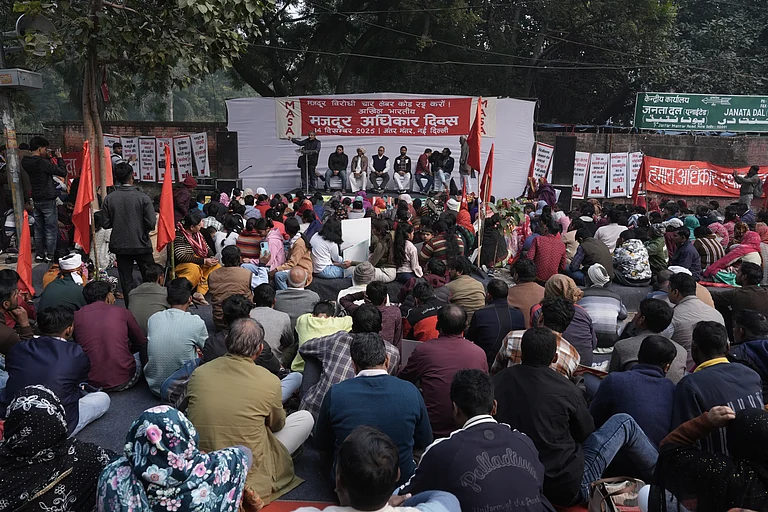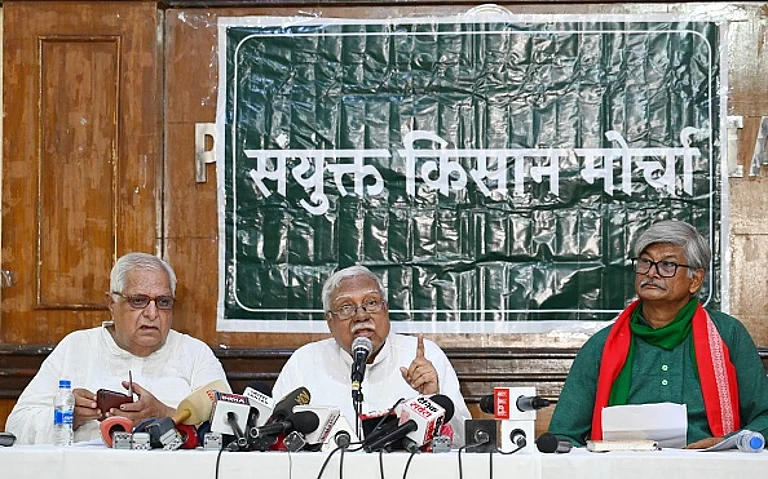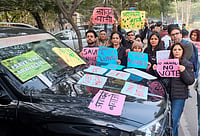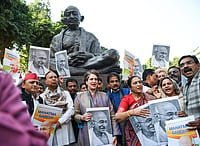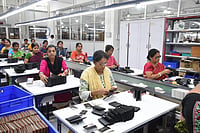
1: Despite the rapid rise of gig work in India, the Periodic Labour Force Survey has not been updated to specifically identify gig workers.
2: Platforms such as Swiggy and Zomato classify the delivery persons as “partners” rather than employees, making the partnership label more of a burden than a privilege.
3: Drivers working with Uber and Ola claim that around 30% of each ride’s earnings are consumed by platform commissions, GST and fuel costs.
Narayan Malik works a minimum of 12 hours a day as a Swiggy delivery partner, one of more than two lakh people who depend on the platform for their income. He eats by the road, come rain, heatwave or Delhi’s biting cold. Delivering while sleep deprived, he got into an accident last year, sustaining a leg injury that persists to this day.
Perched on a staircase during the hectic lunch rush, as order alerts chimed incessantly on his phone, he spoke about what it truly means to carry the tag of “partner,” something he has been doing since 2016.
“Since we are considered ‘partners’, we are considered a business entity, and we pay TDS accordingly," he alleged, “it is our petrol, our labour, yet no one listens to our demands”. The sole breadwinner for his family, he lives in Madanpur Khadar with his bedridden parents whose treatment he can barely afford.
Talking about getting his parents treated at a government hospital, he said with frustration, “They don’t care for the poor — two people are made to share a single bed.”
He also has to care for his wife and their one-month-old baby. On a good day, he brings home no more than ₹1,000 — and that’s before deducting the cost of petrol.
The only benefit is the flexible work hours, he said, though even that hardly feels worth it.
Malik said the platforms attract workers by advertising that one can join for as little as rupees 2, but additional charges as much as rupees 1500 soon follow. Riders are required to purchase their own Swiggy or Zomato T-shirts and the delivery box—without which they often face difficulty entering malls or restaurants to collect orders.
“Why should we pay for T-shirts when they’re clearly for the company’s advertisement? Each t-shirt costs me rupees 150 and the bag is 350 rupees, and I have to buy it again when it wears out,” he said.
With education only up to Class 8th and no specialised skills, he finds himself trapped in the gig economy, shuttling between Zomato, Swiggy, Porter, and other platform-based jobs. “We get an incentive of ₹100 after completing orders worth ₹500. I think to myself, at least it covers the petrol — but that’s not what an incentive is meant for,” he said.
Gig workers were formally brought into India’s legal framework through the Code on Social Security, 2020. Under Chapter I, Section 2(35), a gig worker is defined as “a person who participates in a work arrangement and earns from such activities outside of a traditional employer-employee relationship.”
Although the definitions distinguish gig workers from both formal and informal categories, they stop short of offering clarity on who exactly qualifies as a gig worker or the precise nature of gig work.
NITI Aayog’s 2022 report, India’s Booming Gig and Platform Economy, projects that the gig workforce will expand to 2.35 crore by 2029–30 from the 21, 77 lakh in 2020. Yet, despite such forecasts and attempts at formal definitions, India’s primary source of labour statistics — the Periodic Labour Force Survey (PLFS) — continues to subsume gig work under broad categories such as ‘self-employed’, ‘own-account workers’, or ‘casual labour’. This statistical invisibility has tangible consequences.
In a March 10, 2025, reply to a Rajya Sabha question on whether the government had updated the PLFS methodology to reflect the growth of gig work, the Ministry of Statistics and Programme Implementation stated:
“No updation in the PLFS Schedule has been undertaken with the objective of specifically identifying persons engaged in the gig economy. However, all market activities i.e. activities performed for pay or profit which result in production of goods and services for exchange are included under the domain of economic activity considered in PLFS. The activity situation of a person who is found to be working or being engaged in economic activity during a specified reference period is associated with employment in PLFS. Hence, even the persons engaged in ‘gig economy’ for pay & profit are covered in PLFS.”
The central question is that of the “master–servant relationship,” said lawyer Rajiv Arora. If food deliveries are being carried out under the label of “partners,” he argued, then this is clearly a case of “subterfuge.”
“If the companies have entered into contracts with them, even on a commission basis, there is still a master–servant relationship. It ultimately depends on how the contracts have been structured.”
Recent policy measures — such as e-Shram registration, the issuance of digital ID cards, and health coverage under the Ayushman Bharat Pradhan Mantri Jan Arogya Yojana — signal the state’s acknowledgment of the gig and platform workforce.
However, without corresponding changes in statistical systems like the PLFS, the data intended to guide and monitor these interventions will remain far from being truly inclusive.
Tucked beneath the Jamia Millia Islamia (JMI) Metro Station lies one of Blinkit’s bustling dark stores, a retail outlet or distribution centre meant for e-commerce. The warehouse-like outpost hums with urgency, delivery riders clustering around it like bees to a hive, their bikes weaving in and out in a constant rush.
The delivery partners there recently went on strike after the platform removed the option to refuse or “unassign” an order, claimed Adil, one of the many riders constantly on the move within a three-kilometre radius. According to him, if a delivery partner unassigned an order, the platform would suspend their ID for the next six hours.
Twenty-year-old Adil, the eldest sibling, supplements his father’s meagre salary to fund his siblings’ education and keep the household afloat. Under the shade of the metro pillars, he has forged a brotherhood with other delivery partners who gather there every day — swapping stories of the day’s grind and enduring at least 12 relentless hours side by side.
The delivery partners are subject to constant changes, particularly in the algorithm that powers the platform applications. Riders at Blinkit dark store claimed, initially, they would receive a high volume of orders and could be assigned to more profitable areas. But over time, the algorithm shifts, reducing their earnings potential.
“The store is also over-hiring; there aren’t enough orders for all of us,” said Shakir, who drives a school van in the early mornings before beginning his delivery shifts for the day, adding that the platform unilaterally exploits their majboori — their compulsion to work.
When asked what he would have done if circumstances were different, Adil replied, “What’s the point of thinking about all this? No wish ever comes true.”
Eternal’s quick-commerce platform, Blinkit—known for delivering everything from milk to gold and silver coins in under 10 minutes—saw its net order value jump 127% in the June quarter to ₹92.03 billion, surpassing Zomato’s food delivery business for the first time, Reuters reported.
Another major challenge facing gig workers is the absence of unified visibility, said Sunand, President of Rajdhani App Workers Union (RAWU). This weakens their collective demands as the workforce remains scattered across multiple platforms nationwide.
A recent survey done by RAWU revealed alarming gaps in basic amenities and safety across 51 dark stores run by Blinkit, Zepto, Instamart, Big Basket and Flipkart Minutes in Delhi. Only 72 percent of stores had toilets and over a third of these lacked running water or regular cleaning. 14 percent offered no safe drinking water, and one-third provided no place for workers to sit during 12-hour shifts. Parking facilities were missing in 40 percent of stores, leaving workers vulnerable to police harassment and accidents.
Health and safety measures were equally poor: most first-aid kits were locked or inaccessible, night workers operated without managerial support. The report warns that the 10-minute delivery model prioritises speed over worker welfare, breaching the Delhi Shops and Establishments Act, the Occupational Safety, Health and Working Conditions Code, 2020.
At the dark store beneath the JMI metro station, workers said the toilet facility relies on the station’s existing washroom. However, they added, the door is kept locked on most days, leaving them without access.
Stating that there are no specific laws guaranteeing the labour rights of gig workers, Saubhik Bhattacharya, General Secretary of the All India Gig Workers' Union (AIGWU), said that while it is a positive step for the government to introduce the Social Security Codes, the first priority should be to grant gig workers formal workplace status.
In a recent meeting convened by the Labour Ministry, which the union attended, Bhattacharya explained that the government has proposed creating a fund, pooled by setting aside a small amount from every order, to be distributed to delivery partners after a specified tenure.
However, he argued that such a model overlooks the nature of gig work, which is neither long-term nor based on specialised skills.
Outlook India reached out to Swiggy, Ola, Uber and Zomato with queries regarding the “partner” classification, algorithmic assignments, commission structures and worker protections, but did not receive a response.
The vast majority of gig workers in the country remain unaware of their rights, with neither the government nor the companies taking meaningful steps to raise awareness.
Subhash Malik has been driving with Uber since 2016, a path he turned to after an accident left him bedridden for over a year and forced him to abandon his earlier profession with a media house.
Initially, the earnings were good, he said, but now a substantial share of his daily income is swallowed up by the platform’s commission and fuel costs. Malik drives his own car to avoid the Uber Fleet rent, which comes with the mandate of sticking to the platform and completing 120 rides a week. “At least 30% of the earnings of each ride is gone in commission, GST and petrol, be it Ola or Uber” he said.
Now in his 50s, Malik finds his prospects limited by age and injury, leaving driving as his only option. His wife, employed on contract at a government school, has gone over four months without pay. He is striving to fund his son’s education, who aspires to become an advocate.
He said that in the event of an accident, the process of claiming medical or car insurance is so cumbersome that he would end up losing days’ earnings just to access it. “I lose income whenever it rains in Delhi and the roads are waterlogged, as I fear the damage it could cause to my vehicle and the heavy expenses I’d be left to bear.”
In 2019 and 2020, the government codified the existing 29 labour laws into four labour codes relating to wages, social security, occupational safety and industrial disputes.
Suman Dasmahapatra, the Karnataka coordinator of the AIGWU explained how the labour codes work out for the gig economy. In the current scenario, the gig workforce is highly volatile, he said.
“Today, one might be working in construction; tomorrow, if there’s no work in that sector, they might shift to gig work.” There’s no formal mechanism to capture such transitions in statistics or data, and no proper process to register someone as a gig worker, he mentioned.
The government is framing the rules, but most of the time it is not going to the grassroots level to conduct research. As a result, many gig workers remain unaware of the benefits available to them, Dasmahapatra explained.
Currently, the challenges faced by gig workers are part of a much larger economic problem. The cracks lie in the structure of the model itself — payouts are strictly tied to the amount of work completed, with no baseline security, Dasmahapatra mentioned. This shift towards a gig-based business system is largely driven by the scale of the employment crisis in India.
He added that with traditional jobs becoming increasingly scarce, gig work is less a matter of preference and more a consequence of the absence of stable, long-term employment opportunities in the economy.
According to him, the first step is to recognise them as “workers” and that the current definition of worker is “very much debatable”.
In 2025, the four labour codes are still awaiting implementation.
As for the states, three Indian states — Rajasthan, Karnataka and Telangana — have introduced legislation for gig and platform workers. The Rajasthan Platform-Based Gig Workers (Registration and Welfare) Act, 2023, requires employers and aggregators to deposit a monthly welfare cess for the benefit of gig workers in the state. Likewise, the Telangana government has proposed the Telangana Gig and Platform Workers (Registration, Social Security, and Welfare) Act, 2025, mandating that aggregators and employers register detailed data on their workers.
However, Sunand noted that for the welfare funds to materialise, platform companies would need to share their revenue management systems with the board to verify the revenue generated.
Zafar Iqbal, who drives for the platform, is burdened by a loan of rupees 3 lakh after his previous business collapsed during the pandemic. With three young daughters to raise, the weight of survival rests on his steering wheel.
He reminisces about his days as a technician—both in India and the Gulf—when he could earn enough to bring home more. Now bound to this job, he calls it a collective illusion, arguing that the promise of driving a cab being profitable is nothing more than false advertising.
“The company cheats us a lot. A few times I have had to pay commission without taking the rides as the platform application malfunctioned,” he said, adding that he remains wary of Uber’s new recharge feature, which would require drivers to pay upfront to avoid commission charges.
“For now, I will keep driving. Beyond that, only God knows what future awaits us,” he said, his voice heavy with resignation. “They promise a lot but deliver nothing—they take and move on.”










